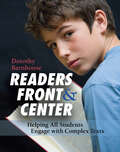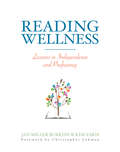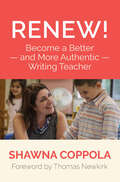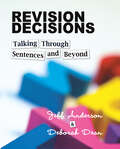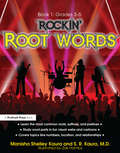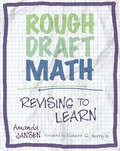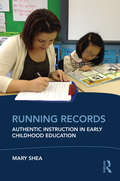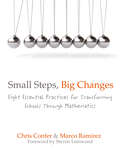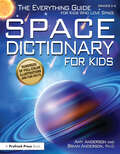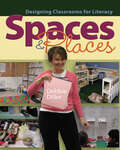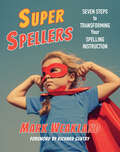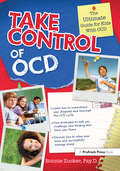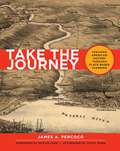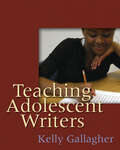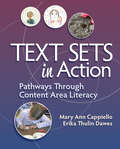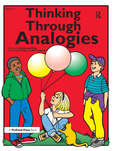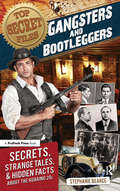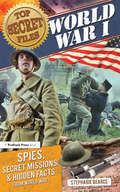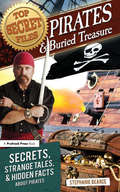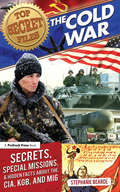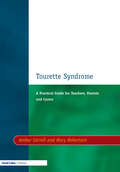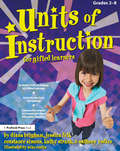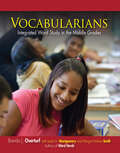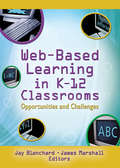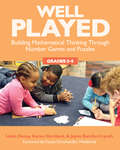- Table View
- List View
Readers Front and Center: Helping All Students Engage with Complex Text
by Dorothy BarnhouseEvery teacher wants and expects his or her students to be reading increasingly complex texts, yet sometimes the gap between our expectations and our students' abilities seems wide and deep. It's tempting to look at that gap and step in to fill it for them, but then we'd be doing most of the heavy lifting the understanding, analysis, and interpretation that our students should be learning for themselves. So how can teachers reverse this trend and ensure that our students are fully entering, absorbing, and experiencing texts? How can we make sure they're making complex meaning independently and proficiently,- as the Common Core State Standards require? Readers Front & Center answers these questions by framing instruction that starts with the student. You'll learn how to do the following: Research and listen to your students so your teaching can be more targetedNotice and name your students' thinking so they can see- what complex thinking looks and sounds likeSet your students up to be problem solversPrepare your students to do increasingly complex thinking in increasingly complex texts Filled with examples of one-on-one conferences, small groups, and whole-class scenarios, this essential book provides an accessible and inspiring model of how-;and why-;we need to put students at the front and center of our teaching.
Reading Wellness: Lessons in Independence and Proficiency
by Jan Burkins Kim YarisWith so many state standards and demands of accountability, it can be a challenge for teachers to teach in ways that create energy and enthusiasm for reading. In their book, Reading Wellness: Lessons in Independence and Proficiency , authors Dr. Jan Burkins and Kim Yaris want to reignite the passion in teachers and drive them to instill confidence, curiosity, and joy in students.Burkins and Yates define reading wellness to include all aspects of readership so we can be our best reading selves-. The book is built around a framework of four intentions: alignment, balance, sustainability, and joy. It includes a series of field-tested lessons that help children read closely and carefully while still honoring their interests, passions, and agency as readers.Reading Wellness encourages each teacher to shape these ideas in ways that support personal ideals and goals while nurturing a love of reading and a passion for lifelong learning.
Renew!: Become a Better and More Authentic Writing Teacher
by Shawna CoppolaWhen was the last time you shook up your writing instruction? In Renew!: Become a Better and More Authentic Writing Teacher, author Shawna Coppola builds on the premise that our students are ever-changing, and so is our collective knowledge base. Instructional strategies that have worked in the past may need to evolve accordingly. Coppola guides K-8 writing teachers with a three-part framework for Rethinking, Revising, and Renewing their approach'sand finding new energy along the way. Using the framework, Renew! examines the most pervasive educational practices in writing instruction and poses questions that guide teachers to revise those practices to ensure they are effective for all students. Coppola believes the work is challenging, yet critical, referencing R. Buckminster Fuller's Knowledge Doubling Curve: According to Fuller's paradigm, the amount of time it takes for us to increase our collective knowledge base by 100 percent will continue to shrink the older we get. If this is true'sor even close to being true'show can we, as educators, ever feel satisfied with teaching our students the same concepts, using the same methodologies and practices, that we have in the past? The book offers a road map for renewing key aspects of our practice, including: How we teach the writing process: Over time and frequent usage, some of our favorite teaching strategies can become rigid. Coppola gives a candid account of how her enthusiasm for the writing process as an undergraduate led her to teach writing for years as a set of pre-determined steps. Now she teaches that there are many variations of the writing process, and many twists and turns along the path. One foundational strategy used is opening up her own process as a writer'sand her writer's notebook'sto students and encouraging them to think and talk about their process with classmates. What we mean by Writing: Coppola argues that drawing isn't an accompaniment to writing; it is writing. Its another form of composition through which students can tell stories, convey ideas, and engage readers. The book is full of visual compositions by students as well as Shawna's wonderfully simple and evocative sketches from her writer's notebook. The tools we use to teach writing: The most ubiquitous tools used to teach writing'sfrom anchor charts to graphic organizers to sentence starters etc.'stend to be teacher-centric rather than student-centric. Renew! invites students into the process of constructing tools that are meaningful and helpful to them. The book includes a range of examples of tools built collaboratively with students. How we assess and evaluate student writing: Coppola draws a distinction between assessment'swhich should be an interactive conversation with students'sand evaluation, which is about judging and categorizing what students know and can do. Renew! offers a range of examples and resources that illustrate effective feedback for student writers, including online videos of teacher-student and peer-to-peer conferences. Renew! also offers ideas for how teachers can nurture their own writing lives and thus reinvigorate their instructional practice. Through rethinking, revising, and renewing their practice, teachers can not only strengthen students' skills as writers, but also nurture students to become critical thinkers, problem solvers, and risk takers in the classroom and in our rapidly-changing world.
Revision Decisions: Talking Through Sentences and Beyond
by Jeff Anderson Deborah DeanRevision is often a confusing and difficult process for students, but it's also the most important part of the writing process. If students leave our classrooms not knowing how to move a piece of writing forward, we've failed them. Revision Decisions: Talking Through Sentences and Beyond will help teachers develop the skills students need in an ever-evolving writing, language, and reading world. Jeff Anderson and Deborah Dean have written a book that engages writers in the tinkering, playing, and thinking that are essential to clarify and elevate writing. Focusing on sentences, the authors use mentor texts to show the myriad possibilities that exist for revision. Essential to their process is the concept of classroom talk. Readers will be shown how revision lessons can be discussed in a generative way, and how each student can benefit from talking through the revision process as a group. Revision Decisions focuses on developing both the writing and the writer. The easy-to-follow lessons make clear and accessible the rigorous thinking and the challenging process of making writing work. Narratives, setup lessons, templates, and details about how to move students toward independence round out this essential book. Additionally, the authors weave the language, reading, and writing goals of the Common Core and other standards into an integrated and connected practice. The noted language arts teacher James Britton once said that good writing floats on a sea of talk. Revision Decisions supports those genuine conversations we naturally have as readers and writers, leading the way to the essential goal of making meaning.
Rockin' Root Words: Book 1, Grades 3-5 (Rockin' Root Words Ser. #1)
by Manisha Shelley Kaura S.R. KauraIf your students like Red Hot Root Words, they are going to love Rockin' Root Words, an exciting twist on vocabulary development! In these comprehensive books, students will enjoy learning the roots, suffixes, and prefixes of more than 500 common vocabulary, words presented in an easy-to-follow style that utilizes visual learning and word maps to enhance student comprehension and memory.By teaching students word parts using word webs, graphic organizers, and cartoons, teachers can ensure that every student in their classroom understands the basics of vocabulary development. Book 1 is focused on vocabulary for grades 3-5 and covers a variety of topics, including numbers, colors, family and relationships, location and distance, and scientific vocabulary.Grades 3-5
Rough Draft Math: Revising to Learn
by Amanda JansenTalking and writing about unfinished ideas is vital to learning mathematics, but most students only speak up when they think they have the right answer - especially middle school and high school students. Amanda Jansen and her collaborating teachers have developed a breakthrough approach to address this challenge. Rough Draft Math: Revising to Learn, Jansen shares the power of infusing math class with the spirit of revision so that students feel comfortable thinking aloud as they problem-solve rather than talking only to perform right answers. Creating a Community of Learners: As part of the rough draft framework, a class of students becomes an equitable and inclusive community of thinkers, one where students feel safe to engage in discourse while developing mathematical competency and confidence Practical Application of Innovative Ideas: This book includes specific teaching techniques and a range of classroom vignettes showing rough draft math in action within a student-centered teaching approach. Children can develop solutions at their own pace and share thought processes behind their conclusions Classroom Tested: Jansen has developed the concept of rough draft math in collaboration with a diverse group of dynamic and reflective teachers. Rough Draft Math' provides a blueprint for educators to allow free-thinking discussion while maintaining the mathematical learning goalsRough Draft Math, Jansen shows how to create an energetic classroom culture where students readily participate and share their evolving understanding while engaging in math talk, collaborative problem solving, and ongoing revision of ideas. '
Running Records: Authentic Instruction in Early Childhood Education
by Mary SheaThe most effective way to understand what a child knows about the reading process is to take a running record. In Running Records, Mary Shea demonstrates how teachers can use this powerful tool to design lessons that decrease reading difficulties, build on strengths, and stimulate motivation, ensuring that children develop self-sustaining learning strategies. Special Features include: a step-by-step outline for taking efficient running records guidance in running record analysis: readers will learn how to use running record data to determine a child’s level of decoding skill, comprehension, fluency, and overall reading confidence a Companion Website offering videos of the running record process, sample running records for analysis, and numerous other resources In order to meet the multi-faceted needs of children in today's classrooms, teachers must be knowledgeable about literacy concepts. Running Records provides that invaluable knowledge, making it an ideal text for literacy courses for pre-service teachers and a key professional reference for in-service teachers.
Small Steps, Big Changes: Eight Essential Practices for Transforming Schools Through Mathematics
by Chris Confer Marco RamirezDuring the past two decades, Chris Confer and Marco Ramirez have worked to deepen and improve mathematics instruction at schools around the country. Wherever they go, they find the raw ingredients for success already present: The potential for positive change lies within each school. Abundance is present in the form of capable children, teachers, coaches, and principals. Potential energy -- what can be -- transforms into kinetic energywhat will beonly when a force is accurately applied to move a school in the right direction. In' Small Steps, Big Changes: Eight Essential Practices for Transforming Schools Through Mathematics, the authors identify eight tested principles that transform what can be an overwhelming process into a set of comprehensible and concrete steps. Each phase of the change process is brought to life through the stories and perspectives of teachers, coaches, and principalsstories that will strike familiar chords for every educator. When teachers make sense of math, students learn to make sense of math, and that can profoundly change the entire culture of a school. In one vivid illustration, the authors tell the story of Pueblo Gardens Elementary School in Tucson, Arizona, where Marco, as principal, and Chris, as instructional coach, worked alongside a group of dedicated teachers. A few years into the change process, Pueblo Gardens -- a school with 96 percent of its students at the poverty level and a high percentage of English language learners -- had 94 percent of students meeting or exceeding state standards in third-grade mathematics. Over time, other grades achieved similarly high scores. And once the test scores rose, they were sustained at high levels.
Space Dictionary for Kids: The Everything Guide for Kids Who Love Space
by Brian Anderson Amy AndersonPacked with hundreds of illustrated definitions about astronomy and space, Space Dictionary for Kids is certain to spark any kid's enthusiasm for the solar system and galaxy. Explore cosmology, stars and galaxies, the solar system, space exploration, and exoplanets and astrobiology. Hop on an astronomy timeline to learn the story of how primitive ancient beliefs evolved over centuries to become a high-technology science. Crack up over the humorous sidebars that expand on the topic of space with examples, explanations, diagrams, quizzes, and even short activities to enhance understanding. Use the references and further reading recommendations at the end to help find more information about astronomy, perfect for assignments or those just wanting to know more about the coolest topic in the galaxy! Divided into sections for quick access to the easy-to-understand definitions and amazing full-color illustrations, Space Dictionary for Kids is a must-have for any kid's home library!Grades 3-6NSTA Recommends
Spaces & Places: Designing Classrooms for Literacy
by Debbie DillerFrom Debbie Diller, author of numerous best-selling books and videos on literacy work stations and small group reading instruction, comes another practical resource filled with ideas you can use immediately to better manage your classroom and support student learning and independence. In Spaces & Places: Designing Classrooms for Literacy' you' ll find a wealth of full-color photos from all sorts of classroom spaces in PreK-5th grade, including well-organized areas for whole group and small group reading instruction, classroom libraries, literacy work stations, teacher desks, and storage areas. You' ll love the before and after pictures and the step-by-step processes outlined for organizing your furniture and cabinets, setting up your room space by space, and using your walls thoughtfully. Diller' has even documented how to pack your room at the end of the year to save time next fall (so you can focus on thinking about instruction) and what to do if you must move all your belongings. Through pictures and text, this unique visual reference answers tough questions educators ask, such as: What do I really need in my room and what' s the best way to set it up? How does my physical classroom impact student learning? How can I find the space I need to teach more effectively? What can I get rid of and how? Where do I put all my stuff?Charts, reproducible forms, motivating quotes, a list of shopping sources, and reflection questions are included, along with a section outlining ten specific suggestions for on-going staff development. Whether or not you implement literacy work stations in your classroom, Spaces & Placesincludes everything you need to look deeply at classroom space and how it supports instruction.
Super Spellers: Seven Steps to Transforming Your Spelling Instruction
by Mark WeaklandMany teachers are frustrated with how spelling is traditionally taught and finding the time to support young spellers with explicit strategy instruction. Author Mark Weakland developed Super Spellers: Seven Steps to Transforming Your Spelling Instruction, an approach to teaching spelling in a way that is research-based and tied to authentic reading and writing. Super Spellers helps teachers understand what their students need through frequent formative assessments. The book focuses on the scope of spelling instruction and teaching spelling strategies to increase students' word-solving skills. Once kids are comfortable and competent spellers they become super readers and writers, too. In addition to step-by-step guidance, each chapter features an If you only have 10 minutes lesson plan segment. The appendix contains word inventories, a sample scope and sequence, examples of spelling list transformation, and word ladder activities.
Take Control of OCD: The Ultimate Guide for Kids With OCD (Take Control Ser. #0)
by Bonnie ZuckerTake Control of OCD: The Ultimate Guide for Kids With OCD is a unique guide just for kids ages 10-16 with Obsessive-Compulsive Disorder to help them take control of their disorder and find success in school and in life. Using a cognitive-behavioral therapy method to stress gradual exposure to students' obsessive thinking patterns, the book takes kids step-by-step through a ladder-based process to conquer their fears and demolish their worries.Focusing on helping kids change their obsessive thoughts, tolerate uncertainty, develop positive self-talk and stress management, advocate for their needs in school, find successful relaxation procedures, and face their fears, the book includes workbook-style pages for kids to complete. By interviewing kids with OCD from across the country, the author offers tons of advice, information, and ideas for students, by students just like them. This handy guidebook is sure to help children with OCD change their behaviors and conquer their worries, discovering a sense of accomplishment and achievement.Ages 10-16
Take the Journey: Teaching American History Through Place-Based Learning
by James PercocoIn Take the Journey: Teaching American History Through Place-Based Learning,' author, historian, and educator James Percoco invites you and your students to the places where many events in American history happened. The Journey Through Hallowed Ground is a 180-mile National Heritage area encompassing such historic sites as the Gettysburg battlefield and Thomas Jefferson's home, Monticello. Though it might prove difficult to visit these particular sites with your students, Percoco argues that every community has a story that can be connected to larger themes in American history and that placed-based history education can be made a part of every classroom, from Nevada to Washington to Pennsylvania. Filled with students' voices and an enthusiasm for American history, Take the Journey offers the following: Practical and easy-to-implement lessons Classroom-tested materials Specific directions for employing place-based best practices in the classroom Ways to meet state standards without sacrificing teacher creativity or hands-on learning Lists of resources and primary source materialsSo bring your students along and let them discover the twists and turns offered by history and the Journey Through Hallowed Ground. '
Teaching Adolescent Writers
by Kelly GallagherIn an increasingly demanding world of literacy, it has become critical that students know how to write effectively. From the requirements of standardized tests to those of the wired workplace, the ability to write well, once a luxury, has become a necessity. Many students are leaving school without the necessary writing practice and skills needed to compete in a complex and fast-moving Information Age. Unless we teach them how to run with it, they are in danger of being run over by a stampede—a literacy stampede. InTeaching Adolescent Writers , Kelly Gallagher shows how students can be taught to write effectively. Gallagher shares a number of classroom-tested strategies that enable teachers to: Understand the importance of teaching writing and how to motivate young writers Show how modeling from both the teacher and real-world texts builds young writers Provide choice of what to write, which helps elevate adolescent writing, and how to fit it into a rigorous curriculum Help students recognize the importance of purpose and audience Assess essays in ways that drive better writing performance. Infused with humor and illuminating anecdotes, Gallagher draws on his classroom experiences and work as co-director of a regional writing project to offer teachers both practical ways to incorporate writing instruction into their day and compelling reasons to do so.
Text Sets in Action: Pathways Through Content Area Literacy
by Mary Ann Cappiello Erika Thulin DawesFinding ways to organize your classroom instruction for knowledge building and literacy learning can be challenging. How can you incorporate more nonfiction and informational text in your content area curriculum while expanding and deepening representation with diverse texts? What can motivate student learning while providing equity and access for different learning styles and needs? Text sets are the answer!In Text Sets in Action: Pathways Through Content Area Literacy, authors Erika Thulin Dawes and Mary Ann Cappiello demonstrate how text sets offer students the opportunity to build critical thinking skills and informational literacy while generating interest and engagement across the content areas. Put your students in the center of the meaning-making in your classroom with multimodal multi-genre text sets in action. In Text Sets in Action, the authors: Model how text sets build foundational skills and metacognitive strategies as students experience a carefully scaffolded and sequenced exploration of ideas, academic, and content vocabularyExplain how text sets encourage classroom discussion by having students ask questions about what they read, debate different perspectives, and relate the texts to their own personal experiences and the changes they would like to see in the worldShow how children's literature and multimodal, multi-genre texts can serve as mentor texts for student writing and inspire creativity and advocacyDemonstrate how to curate text sets that can introduce diverse and underrepresented voices into the classroom, fostering appreciation for different points of view and generate deeper critical thinkingProvide resources and suggestions for designing text sets a multimodal, multi-genre text set can include children's literature of all genres, as well as digital texts, YouTube videos, news articles, podcasts, and more Text Sets in Action will help you create a collection of text sets that can be added to or edited over the years to align with your lesson plan goals. Teachers who have adopted this approach saw greater student reading comprehension and critical thinking skills. By introducing a multitude of text, teachers will ignite a spirit of inquiry and engagement for lifelong learning.
Thinking Through Analogies: Grades 3-6
by Bonnie L. RisbyAn analogy is a comparison between two things. It points out the similarities between two things that might be different in all other respects. Analogies cause us to think analytically about forms, uses, structures, and relationships. This all-time favorite resource not only gives students a chance to practice solving analogies, but also invites them to open their minds to a completely new way of analyzing the elements of analogies. Each page introduces several categories of analogies. Each category expands students' way of viewing the world and contrasting and comparing elements. Thinking Through Analogies also instills the tools whereby students can create relationships to enhance their creative and formal writing, as well as to heighten their critical thinking in test taking. Other books that teach analogies are Analogies for Beginners and Analogies for the 21st Century.Grades 3-6
Top Secret Files: Gangsters and Bootleggers, Secrets, Strange Tales, and Hidden Facts About the Roaring 20s (Top Secret Files Of History Ser. #0)
by Stephanie BearceBlind pigs, speakeasies, coffin varnish, and tarantula juice were all a part of the Roaring 20s. Making alcohol illegal didn't get rid of bars and taverns or crime bosses: They just went underground. Secret joints were in almost every large city and could be entered if you knew the right code words. Discover the crazy language and secret codes of the Prohibition Era—why you should mind your beeswax and watch out for the gumshoe talking to the fuzz or you might end up in the cooler! It's all part of the true stories from the Top Secret Files: Gangsters and Bootleggers. Take a look if you dare, but be careful! Some secrets are meant to stay hidden . . . Ages 9-12
Top Secret Files: World War I, Spies, Secret Missions, and Hidden Facts from World War I (Top Secret Files Of History Ser. #0)
by Stephanie BearceFlame throwers, spy trees, bird bombs, and Hell Fighters were all a part of World War I, but you won't learn that in your history books! Uncover long-lost secrets of spies like Howard Burnham, “The One-Legged Wonder,” and nurse-turned-spy, Edith Cavell. Peek into secret files to learn the truth about the Red Baron and the mysterious Mata Hari. Then learn how to build your own Zeppelin balloon and mix up some invisible ink. It's all part of the true stories from the Top Secret Files: World War I. Take a look if you dare, but be careful! Some secrets are meant to stay hidden . . . Ages 9-12
Top Secret Files: Pirates and Buried Treasure, Secrets, Strange Tales, and Hidden Facts About Pirates (Top Secret Files Of History Ser. #0)
by Stephanie BearcePirates of the Golden Age had to deal with scurvy, fight ferocious battles, and eat everything from monkeys to snakes to sea turtles, but you won't learn that in your history books! Discover the truth about Anne Bonny, the Irish woman who was a true Pirate of the Caribbean, and the secrets of Blackbeard and the daring pirate Cheng I Sao. Then learn how to talk like a pirate and make a buried treasure map for your friends. It's all part of the true stories from the Top Secret Files: Pirates and Buried Treasure. Take a look if you dare, but be careful! Some secrets are meant to stay hidden . . . Ages 9-12
Top Secret Files: The Cold War, Secrets, Special Missions, and Hidden Facts About the CIA, KGB, and MI6 (Top Secret Files Of History Ser. #0)
by Stephanie BearcePoison dart umbrellas and cyanide guns were all a part of the arsenal of tools used by spies of the Soviet KGB, American CIA, and British MI6, but you won't learn that in your history books! Learn the true stories of the Cold War and how spies used listening devices planted in live cats and wristwatch cameras. Discover how East Germans tried to ride zip lines to freedom, while the Cambridge Four infiltrated Britain and rockets raced to the moon. Then make your own submarines and practice writing secret codes. It's all part of the true stories from the Top Secret Files: The Cold War. Take a look if you dare, but be careful! Some secrets are meant to stay hidden . . .Ages 9-12
Tourette Syndrome: A Practical Guide for Teachers, Parents and Carers (Resource Materials for Teachers)
by Mary Robertson Amber CarrollThis handbook provides the knowledge and information required to equip teachers and learning support assistants with the understanding and skills needed when working with pupils with Tourette syndrome. Clinical descriptions and medical treatments are discussed and advice on diagnosis, identification and assessment in the classroom is given. Responding to the learning, emotional and behavioural difficulties pupils may experience, the authors provide multi-disciplinary strategies for application within a school.
Units of Instruction for Gifted Learners: Grades 2-8 (Units Of Instruction For Gifted Learners Ser.)
by Diana Brigham Jessica Fell Constance SimonsLooking for innovative, successful, and engaging units to use in your gifted elementary classroom or pull-out program? Look no further than Units of Instruction, the latest in Prufrock's collection of easy-to-apply units for the classroom.Developed by seasoned teachers in the field of gifted education, the five in-depth units of study in this book cover everything from elementary geometry, to a study of slavery, to the inclusion of a media unit in the social studies curriculum. Worksheets, handouts, answer keys, and teacher guides are included with every lesson, making this book an efficient, easy-to-use part of classroom instruction.Students in grade 2-8 will enjoy taking part in these engaging and interesting units, as they practice their math, science, language arts, and social studies skills in these interdisciplinary studies. Engage your students and capture their interest—include in-depth study in your gifted classroom with Units of Instruction!Grades 2-8
Vocabularians: Integrated Word Study in the Middle Grades
by Brenda L. OverturfBuilding on the ideas developed in Word Nerds: Teaching All Students to Learn and Love Vocabulary , Brenda J. Overturf has updated and energized the recommended practices for middle grades students. Vocabularians is for any educator who wants to help young adolescents increase knowledge and competency with word study while bringing interest, motivation, and even joy to their learning. Brenda takes teachers and administrators inside three middle-level schools where educators are integrating vocabulary instruction across the curriculum. In rural, urban, and suburban settings, she highlights effective ways to develop students' vocabulary skills using art, music, games, technology, reading, writing, speaking, listening, and critical thinking. Vocabularians shows teachers of all content areas how to build word networks, flood the classroom environment with academic vocabulary, and incorporate the three word-solving strategies that researchers have found to be the most important-;teaching students how to use context; deciphering words by breaking down prefixes, suffixes, and root words; and using reference materials in authentic ways. By blending current research with real classroom experience and application, Brenda builds on her work with Margot Holmes Smith and Leslie Montgomery and offers an easy-to-implement, customized-to-middle-school resource that will improve instruction and assessment. As one featured seventh grader shared: Vocabulary helps you because the more you know words, the more fluent you can be in reading, the better you can read and write, and the better your writing sounds. There's always going to be a time when you have to sound professional, whether you're applying for a job or anything else. You're just going to have to know how to use a good vocabulary.-
Web-Based Learning in K-12 Classrooms: Opportunities and Challenges
by James Marshall Jay BlanchardMake sure your students get the most from their online learning experiencesEven though nearly every K-12 public school in the United States has broadband Internet access,the Web&’s vast potential as a teaching and learning tool has still not been realized. Web-based learning opportunities have been expensive, slow to develop, and time-consuming to implement, despite pressure on schools to adopt technology solutions that will cure their educational ills. Web-Based Learning in K-12 Classrooms: Opportunities and Challenges chronicles the up and downs of online learning and offers unique insights into its future, providing a comprehensive, curriculum-wide treatment of K-12 content areas (reading, science, mathematics, social studies), special education, counseling, virtual schools, exemplary schools, implementation issues, and educational Web sites.The Internet represents a powerful, complex set of technologies that offers your students access to unlimited knowledge-but that access doesn&’t replace the human interactions found in classrooms. Placing a student in front of a computer monitor is a supplement to classroom learning, not a substitute for it. Academics and education professionals address questions surrounding the key issues involved in successfully incorporating the wide range of Web-based learning opportunities (formal courses, demonstrations, simulations, collaborations, searches) into the classroom, including technology, content, and implementation.Web-Based Learning in K-12 Classrooms examines: inquiry-based learning online interaction displaying student work online Internet accessibility for students with disabilities initiating school counselors into e-learning technologies the role of government in virtual schools Web-based schools in California, Virginia, Pennsylvania, Vermont, and Texas a 13-category classification system for online educational resources the ATLAS model for program implementation evaluations of more than 1,000 pieces of online information (articles, research, reports, news, and statistics) and 900 Web applications (tutorials, drills, games, and tests) with evaluation criteriaWeb-Based Learning in K-12 Classrooms is a vital resource for educators interested in online learning applications across the K-12 curriculum.
Well Played, Grades 3-5: Building Mathematical Thinking Through Number Games and Puzzles
by Linda Dacey Karen Gartland Jayne Bamford LynchStudents love math games and puzzles, but how much are they really learning from the experience? Too often, math games are thought of as just a fun activity or enrichment opportunity. Well Played, Grades 3-5: Building Mathematical Thinking Through Number Games and Puzzles shows you how to make games and puzzles an integral learning component that provides teachers with unique access to student thinking. The twenty-five games and puzzles in Well Played, Grades 3-5 which have all been field-tested in diverse classrooms, contain: Explanations of the mathematical importance of each game or puzzle and how it supports student learning Variations for each game or puzzle to address a range of learning levels and styles Classroom vignettes that model how best to introduce the featured game or puzzle The book also includes a separate chapter with suggestions for how to effectively manage games and puzzles in diverse classrooms; game boards, game cards, and puzzles; assessment ideas; and suggestions for online games, puzzles, and apps. Well Played, Grades 3-5 will help you tap the power of games and puzzles to engage students in sustained and productive mathematical thinking.
